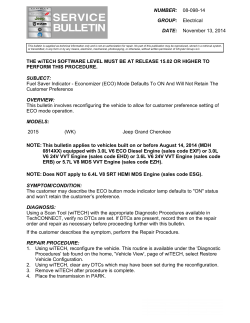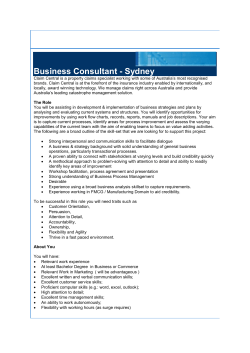
Eco Warriors to the Rescue! - NLA Publishing
Eco Warriors to the Rescue! Teaching Notes by Tania McCartney, with teaching notes by Tania McCartney Book Details Banjo, Ned and Matilda are no ordinary kids. They’re eco warriors with a passion for conserving our native flora and fauna. Join these intrepid travellers as they embark on a magical adventure into the Australian native landscape. Entering the very pages of their favourite book, the warriors interact with lots of different wildflowers including a kangaroo paw, a banksia and a waratah. Along the way, these clever kids look for ‘tips’ that tell them how to ensure the survival of our native landscape for generations to come. Can these eco-warriors help protect our native flora from bushfires, pollution and unwise development? Combining modern photography and typesetting with historical artworks from the National Library of Australia collections, Eco Warriors to the Rescue! makes the Library’s botanical art accessible to the very young. The book also includes interesting facts about Australian flora, floral emblems and birth months, and further ideas on how to keep Australian green. Teaching Notes – Eco Warriors to the Rescue! by Tania McCartney page 1 About the Author Tania McCartney (www.taniamccartney.com) is an author of books for both adults and children. An experienced editor, speaker, magazine writer and founder of Kids Book Review, Tania is particularly passionate about history and Australiana. She has long been obsessed with the creations of Australia’s early botanical artists, which feature heavily in this book, and her passion for photography and book design is behind the unique construction and layout of Eco Warriors to the Rescue! Tania lives in Canberra with her husband, two children and a mountain of books. Teaching Notes These teaching notes are designed for students in lower to middle primary school. There are also activities for upper primary students. All the activities are ideal for complementing science, geography, environment and history study units. They also complement the use of the internet, research and appreciation for the National Library of Australia’s digital collection. Book Study Botanical Artwork The idea behind Eco Warriors to the Rescue! was to provide a narrative format to showcase some of the images from the NLA’s stunning collection of historical, botanical art—a collection few children would have the opportunity to view. For lower to middle primary: Have your students choose a botanical image from the book and create their own likeness of the plant, using paint, pencils or crayons. They may also like to draw themselves interacting with the plant. For upper primary: Have the children complete their own botanical image and label it according to the plant’s common name and botanical name. They could also photograph themselves and their classmates, and superimpose these photographic images onto their artwork. The NLA Digital Image Collection The children’s books published by the National Library of Australia require use of its extensive digital collection of photographs, sketches, prints, paintings, ephemera and other imagery. Eco Warriors to the Rescue! incorporates images from this collection. For lower to middle primary: Visit the Library’s digital image collection at catalogue.nla.gov.au and have the students search for botanical images from the book by using the ‘search’ box. Refine the search by clicking on the drop down menus next Teaching Notes – Eco Warriors to the Rescue! by Tania McCartney page 2 to the search field. For example, students can ‘add limits’ by choosing to search for ‘Picture’ only. Can students find the images in the book? Can they find images of plants located in or near your school? For upper primary: Have children choose an image from the collection, then discuss the image cataloguing details and the meaning behind the following: Bib ID—bibliographical identifier Format—a picture and whether it is available online Online versions—shows the enlarged image Notes—details of the image and how the title was devised Subjects—which ‘tags’ the image is filed under Research In compiling Eco Warriors to the Rescue!, the author researched its content on the internet and through books, images from the Digital Collection and discussion with a local native plant expert. For lower to middle primary: Discuss with children ways they could research a book of this nature. If they were compiling a book about the plants in their garden at home, who might they approach and where might they look for more information? Have the children choose a plant from their home garden (or school) and draw a small diagram with accompanying text on any fascinating information they find. For upper primary: Have children choose five plants from their own garden or school garden. Research these plants and provide a pictorial essay. Or, have the children research the parts of a plant, draw a plant diagram and label it. The Environment For lower to middle primary: Discuss the ten environmental ‘tips’ noted in Eco Warriors, and how children could use these tips themselves. Discuss why the tips are important. (See end of these teachers’ notes for more Q&A on these tips.) ● Don’t litter. ● Tread carefully while bushwalking. ● Never pick native flowers. ● Keep our waterways clean. ● Protect plants from introduced animals. ● Care for native animals and insects. ● Plant native trees and shrubs. Teaching Notes – Eco Warriors to the Rescue! by Tania McCartney page 3 ● Plan development wisely (housing, road works, farming, mining and forestry). ● Prevent bushfires. ● Reduce pollution. For upper primary: Divide children into 10 groups and have them take on one of the tips listed above. Have them discuss and then present their ideas on: a) why this tip is vital b) how they can implement their tip. As an extension, have them present their tip as an advertising slogan for community use. Class Activity Option 1 For lower to middle primary: Organise a tree planting at your school. Research the type of trees you wish to plant and why they are suited to your school’s environment. Invite the entire school and perhaps even parents. For upper primary: Leave the research and organisation of the tree-planting in their hands. Option 2 For lower to middle primary: Recreate the signs for the environmental tips shown in the book. Have the children work on large posters for each one. Post them around the school. For upper primary: Have the children create a short film using the tips from the book. Have all children play a role in the film and showcase the film at assembly. Eco Facts For upper primary: Discuss the following facts: ● A great number of Australia’s native plants, animals and birds exist nowhere else in the world. ● Australia is one of just 17 countries said to be biologically ‘megadiverse’. There are over 20,000 flowering plant species and over 250,000 species of fungi and lichens in Australia. ● The most common flora is the hummock (or spinifex) grasslands, estimated to be 23 per cent of the total green flora of Australia. ● The largest area of eucalypts is in Queensland. Teaching Notes – Eco Warriors to the Rescue! by Tania McCartney page 4 ● The largest area of acacia shrubland is in Western Australia. ● Queensland contains almost half (45 per cent) of all known Australian plant species. ● In the last 200 years, over 60 Australian plant species are believed to have become extinct. ● More than 500 plants are currently endangered and over 600 are vulnerable to extinction. ● Eighty-five per cent of Australia's plant species are native, and new species are being discovered all the time. ● In 1994, a Wollemi Pine was found in the Blue Mountains. It descends from a species that lived in the dinosaur era, around 65 million years ago. ● One of the best things you can do to keep our environment healthy is to grow native plants—but they should be the species that have always grown in your area. Botanical Names For upper primary: Discuss the following botanical and common names, and interesting facts. Banksia oblongifolia (no common name) May Gibbs used the flowers of the banksia for the Banksia Men in her Snuggle Pot and Cuddle Pie children’s book series. Anigozanthos bicolor (Little Kangaroo Paw) The Little Kangaroo Paw is found in only one small area—in the south-western corner of Western Australia. Hakea pachyphylla (no common name) Be careful when pushing your nose in to smell the hakea—also known as a ‘needle bush’! Hoya australis (Wax Plant) The Wax Plant has a strong, sweet scent, and is adored by birds due to its abundant nectar. Brachychiton acerifolius (Flame Tree) The Flame Tree was made famous by rock band called Cold Chisel. Its seed pods contain dangerous, irritating hairs that can be easily inhaled. Elaeocarpus grandis (Blue Quandong) During their long travels through central Australia, explorers Charles Sturt and John Stuart prevented scurvy by eating wild fruits like the vitamin C–packed quandong. Teaching Notes – Eco Warriors to the Rescue! by Tania McCartney page 5 Grevillea parallela (Silver Oak) Aboriginal people added water to the nectar of certain grevillea flowers to make a sweet drink. Telopea speciosissima (New South Wales Waratah) The first white people in Australia adopted the Aboriginal name ‘waratah’ for this plant. ‘Waratah’ means ‘red flowering tree’. Acacia saligna (Golden Wreath Wattle) Early white settlers used the branches of wattle trees to make the framework for houses, which were then daubed with mud. They were called ‘wattle-and-daub’ huts. Clematis aristata (Wild Clematis) Wild Clematis is also called Goat's Beard or Old Man's Beard. Eucalyptus sieberi (Silvertop Ash) Honey is produced from the flowers of the Silvertop Ash. Question Time 1 What does flora mean? 2 When walking in the bush, why is it important to watch where we’re treading? 3 Should we pick native flowers? Explain your answer. 4 Why is it important to keep our waterways clean? 5 What kind of damage can introduced animals do to native plants? 6 Why are native animals, birds and insects important for our native plants? 7 Why are controlled fires so important? 8 How many native plants should we plant at home or at school? 9 In what ways can we plan development more wisely? 10 How can we act to reduce pollution? 11 In what ways can be educate ourselves and others about our native plants? Answers 1 Flowers, bushes, trees and other plants. 2 It’s easy to crush and destroy native plants and their seeds. 3 No. Picking any species, especially those endangered, lessens their chance of survival. 4 Because many plants rely on this water, and healthy water means healthier soil and healthier native animals. Teaching Notes – Eco Warriors to the Rescue! by Tania McCartney page 6 5 They eat the seeds, leaves, stalks and roots, destroying any chance of regeneration. Introduced species like rabbits are a big problem because of their large numbers. 6 Native animals and native plants help each other exist. The plants provide food for the animals, and the animals help spread the plants’ seeds. 7 They burn off undergrowth and other highly flammable plant matter, which helps prevent major, highly destructive bushfires. Some native plants rely on fire to burst their seed pods, and so regenerate. 8 The more the better! Planting native trees and shrubs attracts native wildlife, and together they help each other thrive. 9 We need to be mindful of the loss of native flora when building housing and roads. We should also carefully consider the effects of mining and forestry on our environment. 10 There are many ways—but we can start by saving water, turning off lights and electrical appliances when we’re not using them, recycling, not littering, limiting our use of cars, only buying what we need, and eating less packaged and processed food. We can grow our own food, collect rainwater, create compost heaps and walk, ride bikes and catch public transport. Can you think of any other ways you can help reduce pollution? 11 We can share whatever we learn—from school, books and the internet. We can also make an effort to plant native flora and witness the change it makes to our environment. For more teachers’ resources, see Tania’s literary site, Kids Book Review at www.kidsbookreview.com. Teaching Notes – Eco Warriors to the Rescue! by Tania McCartney page 7
© Copyright 2025









